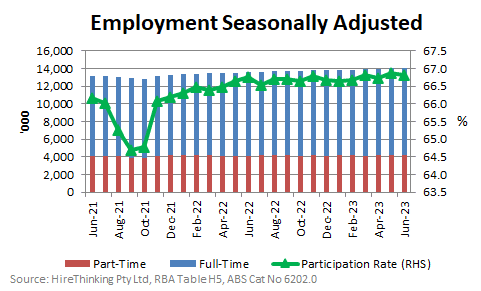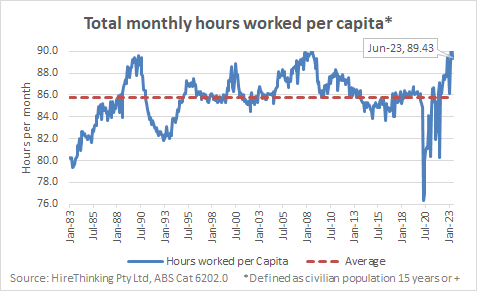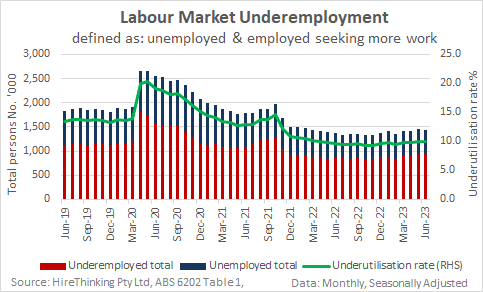Date: 31 July 2023
Australia’s headline unemployment rate remained virtually unchanged at 3.5% in June, with the number of people employed increasing by 32,600, the number unemployed down 10,860 and the participation rate steady at 66.8%. That’s good news, of course, but it underscores some of the several challenges a tight labour market creates and leaves us wondering if the nation is beginning to suffer from its very low unemployment rate.
The ‘narrow path to a soft landing’ for the total economy may have become wider with the employment data for June showing this continued strength. Despite twelve increases in official interest rates to curb swingeing inflation, employment has yet to take the traditional hit. As James Thomson wrote in the AFR, that fact is providing households with the capacity to cover the costs of otherwise disastrous inflation.

Forecasts from the RBA expect inflation to move back within the target band of 2-3% per annum by early 2025, with unemployment forecast to increase to 4.5% in conjunction. It’s a kind of binary loved by central bankers, like a law of economic physics where ‘every action has an equal and opposite reaction’.
Ultimately, the outlook for unemployment will depend on the strength of the economy and whether further interest rate rises are needed for inflation to return to the target band within a timeframe that continues to keep inflationary expectations and outcomes anchored. But if inflation can land on the runway of the target band in an orderly manner, perhaps unemployment will not rise significantly.
If unemployment does rise on the journey to lower inflation, the response would be po-faced, along the lines of ‘inflation is lower, these are the consequences, the rob Peter to pay Paul binary is confirmed’.
Yes, well maybe, but right now, productivity has crashed as we observe in the next item in Stats Count. There is much to say about productivity, but essentially it is a measure of how effectively the economy deploys its assets. What that probably means right now is Australia is thrusting all available labour at tasks and at the margin, doing so with little or no regard for whether that is the right approach.
Much of this is by necessity, sectors of the timber building products industry report that while they wait for new equipment to arrive, they have employed additional people to do jobs that will shortly be replaced by automated lines, for example. That is not the most productive use of the available workforce, soaking up labour instead of deploying capital.
Marginal churn in the labour market is also an issue right now. People starting jobs only to quit them the next day or week for something better is entirely reasonable from a personal standpoint. Especially when the jobs may have limited career prospects. For the nation however, that friction of labour movement or churn is entirely unproductive, adding to the productivity woes.
Reflecting the tight labour market, hours worked increased 4.7% over the past 12 months, outpacing the 3.0% increase in employment suggesting demand for labour is continuing to be met to a large extent by people working more hours. Unsurprising given that data, Australia now has 70.2% of employed people in full time work, the highest level in more than a decade.

Similarly, underemployment, which is defined as the sum of those who are unemployed and those underemployed (employed but seeking more work), was steady at 6.4%. That feeds into a labour market underutilisation rate of 9.9%, a level around which this important measure has hovered for most of the last year.

Labour market underutilisation is important. It tells us that while our unemployment rate is low, and despite the fact the nation is not using its deployed labour as effectively as it might – the productivity story coming up next! – it still needs to do better to ensure it utilises all the available labour effectively.
That’s no easy feat because far from ‘giving everyone a job’, the economy would need to have available work needing to be done, systems (often called businesses) to do that work, and all the inputs, materials and supplies needed to get that work done.



